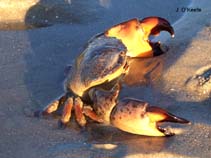| Family: |
Menippidae (stone crabs) |
| Max. size: |
|
| Environment: |
benthic; marine; depth range 0 - 60 m |
| Distribution: |
Western Central Atlantic: from Mexico to Turks and Caicos, then Cape Lookout North Carolina south to Jamaica. |
| Diagnosis: |
Carapace transversely oval, about 2.3 times as long as wide, convex, nearly smooth to unaided eye, minutely granulate and punctate; anterolateral margins (excluding outer orbital teeth) divided into 4 lobes, front (excluding inner orbital angles) with a median notch and a broad tri-lobate lobe on each side. Pincers large and heavy, unequal, nearly smooth; inside of hands with patch of fine, oblique, parallel striae; walking legs stout and hairy distally. Color: juveniles dark purplish blue, very young with legs banded cream and red and white spot on carpus of pincer. Older individual become dark brownish red to black or less mottled and spotted with dusky grey; fingers dark; walking legs with reddish and yellow bands. |
| Biology: |
Occurs at depths down to 60 m (Ref. 114309). Burrows in mudflats just below low-tide mark, among rocks on jetties, on offshore reef areas, under rocks or coral heads and among dead shells or grass clumps (Ref. 367), burrows in seagrass beds, oyster reefs and crevices in rocks (Ref. 114309). Occasionally burrow in colonies. Tolerant to salinities considerably lower or higher than 35. Somewhat active both day and night, greatest activity observed during the evening before dark. Preys on oysters and other mollusks (Ref. 367). |
| IUCN Red List Status: |
Not Evaluated (N.E.) Ref. 123251)
|
| Threat to humans: |
|
| Country info: |
|
Source and more info: www.sealifebase.org. For personal, classroom, and other internal use only. Not for publication.

